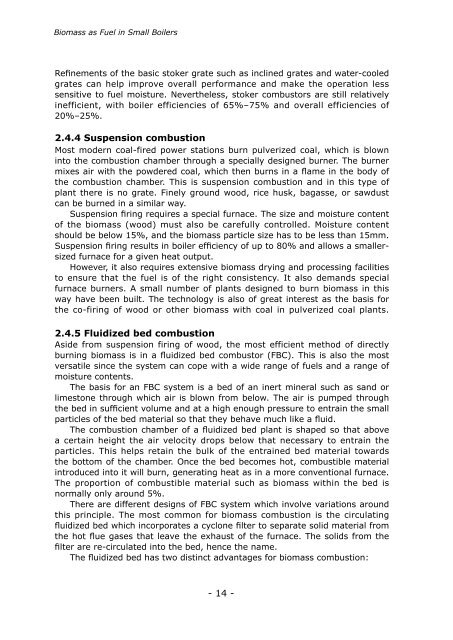Biomass as Fuel in Small Boilers (PDF 6.4 - APO Asian Productivity ...
Biomass as Fuel in Small Boilers (PDF 6.4 - APO Asian Productivity ...
Biomass as Fuel in Small Boilers (PDF 6.4 - APO Asian Productivity ...
Create successful ePaper yourself
Turn your PDF publications into a flip-book with our unique Google optimized e-Paper software.
<strong>Biom<strong>as</strong>s</strong> <strong>as</strong> <strong>Fuel</strong> <strong>in</strong> <strong>Small</strong> <strong>Boilers</strong><br />
Ref<strong>in</strong>ements of the b<strong>as</strong>ic stoker grate such <strong>as</strong> <strong>in</strong>cl<strong>in</strong>ed grates and water-cooled<br />
grates can help improve overall performance and make the operation less<br />
sensitive to fuel moisture. Nevertheless, stoker combustors are still relatively<br />
<strong>in</strong>efficient, with boiler efficiencies of 65%–75% and overall efficiencies of<br />
20%–25%.<br />
2.4.4 Suspension combustion<br />
Most modern coal-fired power stations burn pulverized coal, which is blown<br />
<strong>in</strong>to the combustion chamber through a specially designed burner. The burner<br />
mixes air with the powdered coal, which then burns <strong>in</strong> a flame <strong>in</strong> the body of<br />
the combustion chamber. This is suspension combustion and <strong>in</strong> this type of<br />
plant there is no grate. F<strong>in</strong>ely ground wood, rice husk, bag<strong>as</strong>se, or sawdust<br />
can be burned <strong>in</strong> a similar way.<br />
Suspension fir<strong>in</strong>g requires a special furnace. The size and moisture content<br />
of the biom<strong>as</strong>s (wood) must also be carefully controlled. Moisture content<br />
should be below 15%, and the biom<strong>as</strong>s particle size h<strong>as</strong> to be less than 15mm.<br />
Suspension fir<strong>in</strong>g results <strong>in</strong> boiler efficiency of up to 80% and allows a smallersized<br />
furnace for a given heat output.<br />
However, it also requires extensive biom<strong>as</strong>s dry<strong>in</strong>g and process<strong>in</strong>g facilities<br />
to ensure that the fuel is of the right consistency. It also demands special<br />
furnace burners. A small number of plants designed to burn biom<strong>as</strong>s <strong>in</strong> this<br />
way have been built. The technology is also of great <strong>in</strong>terest <strong>as</strong> the b<strong>as</strong>is for<br />
the co-fir<strong>in</strong>g of wood or other biom<strong>as</strong>s with coal <strong>in</strong> pulverized coal plants.<br />
2.4.5 Fluidized bed combustion<br />
Aside from suspension fir<strong>in</strong>g of wood, the most efficient method of directly<br />
burn<strong>in</strong>g biom<strong>as</strong>s is <strong>in</strong> a fluidized bed combustor (FBC). This is also the most<br />
versatile s<strong>in</strong>ce the system can cope with a wide range of fuels and a range of<br />
moisture contents.<br />
The b<strong>as</strong>is for an FBC system is a bed of an <strong>in</strong>ert m<strong>in</strong>eral such <strong>as</strong> sand or<br />
limestone through which air is blown from below. The air is pumped through<br />
the bed <strong>in</strong> sufficient volume and at a high enough pressure to entra<strong>in</strong> the small<br />
particles of the bed material so that they behave much like a fluid.<br />
The combustion chamber of a fluidized bed plant is shaped so that above<br />
a certa<strong>in</strong> height the air velocity drops below that necessary to entra<strong>in</strong> the<br />
particles. This helps reta<strong>in</strong> the bulk of the entra<strong>in</strong>ed bed material towards<br />
the bottom of the chamber. Once the bed becomes hot, combustible material<br />
<strong>in</strong>troduced <strong>in</strong>to it will burn, generat<strong>in</strong>g heat <strong>as</strong> <strong>in</strong> a more conventional furnace.<br />
The proportion of combustible material such <strong>as</strong> biom<strong>as</strong>s with<strong>in</strong> the bed is<br />
normally only around 5%.<br />
There are different designs of FBC system which <strong>in</strong>volve variations around<br />
this pr<strong>in</strong>ciple. The most common for biom<strong>as</strong>s combustion is the circulat<strong>in</strong>g<br />
fluidized bed which <strong>in</strong>corporates a cyclone filter to separate solid material from<br />
the hot flue g<strong>as</strong>es that leave the exhaust of the furnace. The solids from the<br />
filter are re-circulated <strong>in</strong>to the bed, hence the name.<br />
The fluidized bed h<strong>as</strong> two dist<strong>in</strong>ct advantages for biom<strong>as</strong>s combustion:<br />
- 14 -
















